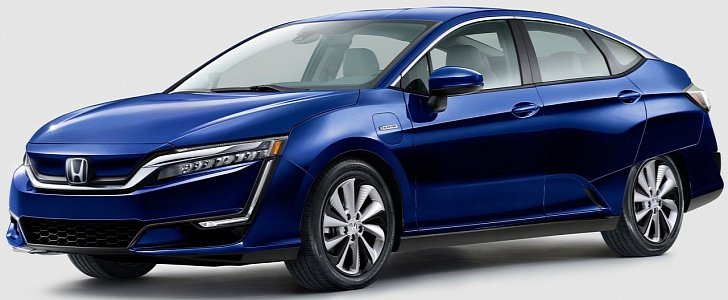Honda has made it very clear over the past few weeks that it plans to become an important player in electric vehicles market, but for now, there's a big gap between what the Japanese brand's plans and what it currently offers.
After years of developing the liquid hydrogen fuel cell technology on its Clarity Fuel Cell model, Honda managed to snatch the title for the zero emissions vehicle with the highest EPA driving range rating in the U.S. With 366 miles (589 km), that's the longest you can drive in a production vehicle with no tailpipe emissions before you need to replenish its fuel supplies.
But with battery-powered EVs drawing closer to that figure every year, it doesn't look like Honda's title will last for long. As for the adoption of its fuel cell car, I think we all know how that went: just as bad as for the other vehicles using this type of powertrain like the Toyota Mirai or the Hyundai Tucson. Do you think that might have to do with the fact most people have AC sockets at their homes, but no liquid hydrogen reservoirs? It could be.
Now, Honda is giving all the signs of a focus switch on battery-powered EVs, and here we have physical manifestation: the Clarity EV. Yes, it's a Clarity Fuel Cell that had the bits giving it two-thirds of its name removed and replaced with a battery pack.
Not a very large one, mind you, as the Honda Clarity EV only has an EPA-rated range of 89-miles, which is nothing short of pathetic. Sure, other electric cars such as the smart fortwo electric drive have even more limited ranges, but that's a diminutive city car. Its purchase makes sense if you want something to zip around town in that doesn't leave a trail of toxic fumes behind. The Clarity has the size advantage (and the extra seats), but in this scenario - which is the only viable one considering the limited range - it's rather a disadvantage.
The battery size wasn't made public, but we do know its charging times. On level 1 (120v), a full charge takes a whopping 19 hours. Level 2, (230v) cuts that down to just three hours, while level 3 DC charging replenishes 80 percent of the battery in just half an hour. That's the advantage of having a small battery pack.
Honda isn't even selling the Clarity EV. Whoever wants one will have to settle for a lease - $269 per month with a $1,999 down payment (first month lease included) and a 20,000 miles per year limit, even though we suspect not even half of that will be needed by most users.
The Clarity EV should be overlooked as an EV and only seen as Honda's way of making an entry on the market. Much like the Hyundai Ioniq EV (which is still a far superior vehicle), it only marks the company's intentions and sets the stage for what is to follow. Which is a completely new electric car that the Japanese brand will unveil this fall, and electric powertrains (hybrids included) in two-thirds of the cars it would sell in Europe by 2025.
But with battery-powered EVs drawing closer to that figure every year, it doesn't look like Honda's title will last for long. As for the adoption of its fuel cell car, I think we all know how that went: just as bad as for the other vehicles using this type of powertrain like the Toyota Mirai or the Hyundai Tucson. Do you think that might have to do with the fact most people have AC sockets at their homes, but no liquid hydrogen reservoirs? It could be.
Now, Honda is giving all the signs of a focus switch on battery-powered EVs, and here we have physical manifestation: the Clarity EV. Yes, it's a Clarity Fuel Cell that had the bits giving it two-thirds of its name removed and replaced with a battery pack.
Not a very large one, mind you, as the Honda Clarity EV only has an EPA-rated range of 89-miles, which is nothing short of pathetic. Sure, other electric cars such as the smart fortwo electric drive have even more limited ranges, but that's a diminutive city car. Its purchase makes sense if you want something to zip around town in that doesn't leave a trail of toxic fumes behind. The Clarity has the size advantage (and the extra seats), but in this scenario - which is the only viable one considering the limited range - it's rather a disadvantage.
The battery size wasn't made public, but we do know its charging times. On level 1 (120v), a full charge takes a whopping 19 hours. Level 2, (230v) cuts that down to just three hours, while level 3 DC charging replenishes 80 percent of the battery in just half an hour. That's the advantage of having a small battery pack.
Honda isn't even selling the Clarity EV. Whoever wants one will have to settle for a lease - $269 per month with a $1,999 down payment (first month lease included) and a 20,000 miles per year limit, even though we suspect not even half of that will be needed by most users.
The Clarity EV should be overlooked as an EV and only seen as Honda's way of making an entry on the market. Much like the Hyundai Ioniq EV (which is still a far superior vehicle), it only marks the company's intentions and sets the stage for what is to follow. Which is a completely new electric car that the Japanese brand will unveil this fall, and electric powertrains (hybrids included) in two-thirds of the cars it would sell in Europe by 2025.






